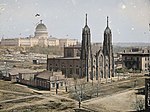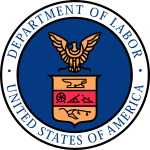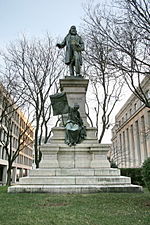Statue of William Blackstone
1920 sculptures1943 establishments in Washington, D.C.Artworks in the collection of the National Park ServiceBronze sculptures in Washington, D.C.Judiciary Square ... and 5 more
Outdoor sculptures in Washington, D.C.Public art stubsSculptures of men in Washington, D.C.Statues in Washington, D.C.Washington, D.C., stubs

Sir William Blackstone is a bronze statue by Paul Wayland Bartlett of the English legal scholar William Blackstone. It is located at E. Barrett Prettyman United States Courthouse, at 333 Pennsylvania Avenue in northwest Washington, D.C., in the Judiciary Square neighborhood.It was installed on August 11, 1943.
Excerpt from the Wikipedia article Statue of William Blackstone (License: CC BY-SA 3.0, Authors, Images).Statue of William Blackstone
Constitution Avenue Northwest, Washington
Geographical coordinates (GPS) Address External links Nearby Places Show on map
Geographical coordinates (GPS)
| Latitude | Longitude |
|---|---|
| N 38.892404 ° | E -77.015814 ° |
Address
Sir William Blackstone Statue
Constitution Avenue Northwest
20001 Washington
District of Columbia, United States
Open on Google Maps









